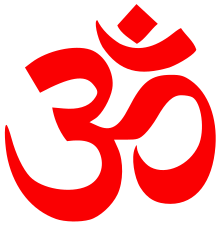
Back Om Afrikaans Om ALS أوم (هندوسية) Arabic ওঁ Assamese Om AST Om Azerbaijani Om BCL Ом (мантра) Byelorussian Ом (мантра) Bulgarian ॐ Bihari




Om (or Aum; ⓘ; Sanskrit: ॐ, ओम्, romanized: Oṃ, Auṃ, ISO 15919: Ōṁ) is a polysemous symbol representing a sacred sound, syllable, mantra, and invocation in Hinduism.[1][2] Its written form is the most important symbol in the Hindu religion.[3] It is the essence of the supreme Absolute,[2] consciousness,[4][5][6] Ātman, Brahman, or the cosmic world.[7][8][9] In Indian religions, Om serves as a sonic representation of the divine, a standard of Vedic authority and a central aspect of soteriological doctrines and practices.[10] It is the basic tool for meditation in the yogic path to liberation.[11] The syllable is often found at the beginning and the end of chapters in the Vedas, the Upanishads, and other Hindu texts.[9] It is described as the goal of all the Vedas. [12]
Om emerged in the Vedic corpus and is said to be an encapsulated form of Samavedic chants or songs.[1][10] It is a sacred spiritual incantation made before and during the recitation of spiritual texts, during puja and private prayers, in ceremonies of rites of passage (samskara) such as weddings, and during meditative and spiritual activities such as Pranava yoga.[13][14] It is part of the iconography found in ancient and medieval era manuscripts, temples, monasteries, and spiritual retreats in Hinduism, Buddhism, Jainism, and Sikhism.[15][16] As a syllable, it is often chanted either independently or before a spiritual recitation and during meditation in Hinduism, Buddhism, and Jainism.[17][18]
The syllable Om is also referred to as Onkara (Omkara) and Pranava among many other names.[19][20]
- ^ a b Jones, Constance; Ryan, James D. (2006). Encyclopedia of Hinduism. Infobase Publishing. pp. 319–20. ISBN 978-0-8160-7564-5.
- ^ a b Beck, Guy L. (2012). Sonic liturgy: ritual and music in Hindu tradition. Columbia: University of South Carolina Press. p. 25. ISBN 978-1-61117-108-2. OCLC 824698506.
- ^ Wilke, Annette; Moebus, Oliver (2011). Sound and Communication: An Aesthetic Cultural History of Sanskrit Hinduism. Berlin: De Gruyter. p. 435. ISBN 978-3110181593.
- ^ James Lochtefeld (2002), "Om", The Illustrated Encyclopedia of Hinduism, Vol. 2: N-Z, Rosen Publishing. ISBN 978-0823931804, page 482
- ^ Holdrege, Barbara A. (1996). Veda and Torah: Transcending the Textuality of Scripture. SUNY Press. p. 57. ISBN 978-0-7914-1640-2.
- ^ "Om". Merriam-Webster (2013), Pronounced: \ˈōm\
- ^ David Leeming (2005), The Oxford Companion to World Mythology, Oxford University Press, ISBN 978-0195156690, page 54
- ^ Hajime Nakamura, A History of Early Vedānta Philosophy, Part 2, Motilal Banarsidass, ISBN 978-8120819634, page 318
- ^ a b Annette Wilke and Oliver Moebus (2011), Sound and Communication: An Aesthetic Cultural History of Sanskrit Hinduism, De Gruyter, ISBN 978-3110181593, pages 435–456
- ^ a b Gerety, Moore; McKean, Finnian (20 May 2015). This Whole World Is OM: Song, Soteriology, and the Emergence of the Sacred Syllable (Thesis). Harvard University, Graduate School of Arts & Sciences. p. 33. ISSN 1746-7527.
- ^ Kudelska, Marta (1 January 2019). Why Is There I Rather Than It?. Peter Lang D. p. 244. doi:10.3726/b17932. ISBN 978-3-631-84429-8.
- ^ https://shlokam.org/texts/katha-1-2-15/
- ^ David White (2011), Yoga in Practice, Princeton University Press, ISBN 978-0691140865, pp. 104–111
- ^ Alexander Studholme (2012), The Origins of Om Manipadme Hum: A Study of the Karandavyuha Sutra, State University of New York Press, ISBN 978-0791453902, pages 1–4
- ^ T. A. Gopinatha Rao (1993), Elements of Hindu Iconography, Volume 2, Motilal Banarsidass, ISBN 978-8120808775, p. 248
- ^ Sehdev Kumar (2001), A Thousand Petalled Lotus: Jain Temples of Rajasthan, ISBN 978-8170173489, p. 5
- ^ Jan Gonda (1963), The Indian Mantra, Oriens, Vol. 16, pp. 244–297
- ^ Julius Lipner (2010), Hindus: Their Religious Beliefs and Practices, Routledge, ISBN 978-0415456760, pp. 66–67
- ^ Misra, Nityanand (25 July 2018). The Om Mala: Meanings of the Mystic Sound. Bloomsbury Publishing. pp. 104–. ISBN 978-93-87471-85-6.
- ^ "OM". Sanskrit English Dictionary, University of Köln, Germany